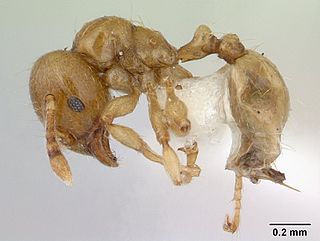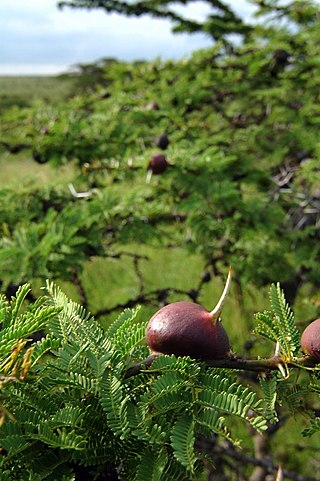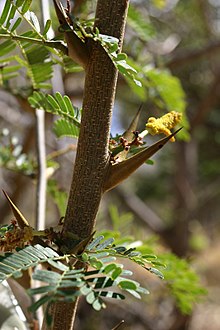
Acacia s.l., known commonly as mimosa, acacia, thorntree or wattle, is a polyphyletic genus of shrubs and trees belonging to the subfamily Mimosoideae of the family Fabaceae. It was described by the Swedish botanist Carl Linnaeus in 1773 based on the African species Acacia nilotica. Many non-Australian species tend to be thorny, whereas the majority of Australian acacias are not. All species are pod-bearing, with sap and leaves often bearing large amounts of tannins and condensed tannins that historically found use as pharmaceuticals and preservatives.

Allomerus decemarticulatus is an Amazonian ant species found in the tropics of South America. This species is most notable for the workers’ complex and extreme predatory behavior, which involves a symbiosis with both a plant and fungal species. They live in leaf pockets of a host plant species, Hirtella physophora. These leaf pockets are areas inside of the plant between the leaves and the stem. Each colony, which consists of about 1,200 workers, inhabits a single tree; however, the ants are spread among the leaf pockets, with typically 40 workers per pocket. Their diet primarily consists of large insects that are captured on the plant, but they also eat some kinds of food bodies produced by the plant as well as its nectar. They are able to capture their prey, which is much larger than themselves, by constructing a platform that acts as a trap for the unsuspecting prey. The ants hide in the trap and attack when any insect lands on it. This technique is an example of ambush predation.

Myrmecophytes are plants that live in a mutualistic association with a colony of ants. There are over 100 different genera of myrmecophytes. These plants possess structural adaptations that provide ants with food and/or shelter. These specialized structures include domatia, food bodies, and extrafloral nectaries. In exchange for food and shelter, ants aid the myrmecophyte in pollination, seed dispersal, gathering of essential nutrients, and/or defense. Specifically, domatia adapted to ants may be called myrmecodomatia.

Thomas Belt, an English geologist and naturalist, was born at Newcastle-on-Tyne in 1832, and educated in that city. He is remembered for his work on the geology of gold bearing minerals, glacial geology, and for his description of the mutualistic relationship between certain bullthorn Acacia species and their Pseudomyrmex ants.
Vachellia sphaerocephala, the bull's horn thorn or bee wattle, is a plant species in the family Fabaceae. The name comes from the shape of the thorns which do indeed resemble the horns of a bull. The tree has a strong, symbiotic relationship with a species of stinging ant, Pseudomyrmex ferruginea. This tree is endemic to Mexico.

Vachellia cornigera, commonly known as bullhorn acacia, is a swollen-thorn tree and Myrmecophyte native to Mexico and Central America. The common name of "bullhorn" refers to the enlarged, hollowed-out, swollen thorns that occur in pairs at the base of leaves, and resemble the horns of a steer. In Yucatán it is called "subín", in Panamá the locals call them "cachito". The trees are commonly found in wet lowlands

Nectar is a sugar-rich liquid produced by plants in glands called nectaries or nectarines, either within the flowers with which it attracts pollinating animals, or by extrafloral nectaries, which provide a nutrient source to animal mutualists, which in turn provide herbivore protection. Common nectar-consuming pollinators include mosquitoes, hoverflies, wasps, bees, butterflies and moths, hummingbirds, honeyeaters and bats. Nectar plays a crucial role in the foraging economics and evolution of nectar-eating species; for example, nectar foraging behavior is largely responsible for the divergent evolution of the African honey bee, A. m. scutellata and the western honey bee.

Vachellia tortilis, widely known as Acacia tortilis but now attributed to the genus Vachellia, is the umbrella thorn acacia, also known as umbrella thorn and Israeli babool, a medium to large canopied tree native to most of Africa, primarily to the savanna and Sahel of Africa, but also occurring in the Middle East.

Myrmecophily is the term applied to positive interspecies associations between ants and a variety of other organisms, such as plants, other arthropods, and fungi. Myrmecophily refers to mutualistic associations with ants, though in its more general use, the term may also refer to commensal or even parasitic interactions.

Pseudomyrmex spinicola is a species of red myrmecophyte-inhabiting neotropical ants which are found only in Nicaragua and Costa Rica. They live in the thorns of tropical trees like Acacia collinsii or Acacia allenii, feeding on nectaries along with the protein and lipid-rich beltian bodies. These bodies are named for Thomas Belt, a naturalist who first described the interactions between acacias and ants in his 1874 book Naturalist in Nicaragua. Belt's book in fact described ants of this species, then unknown.

Vachellia seyal, the red acacia, known also as the shittah tree, is a thorny, 6– to 10-m-high tree with a pale greenish or reddish bark. At the base of the 3–10 cm (1.2–3.9 in) feathery leaves, two straight, light grey thorns grow to 7–20 cm (2.8–7.9 in) long. The blossoms are displayed in round, bright yellow clusters about 1.5 cm (0.59 in) diameter.

Vachellia drepanolobium, more commonly known as Acacia drepanolobium or whistling thorn, is a swollen-thorn acacia native to East Africa. The whistling thorn grows up to 6 meters tall. It produces a pair of straight spines at each node, some of which have large bulbous bases. These swollen spines are naturally hollow and occupied by any one of several symbiotic ant species. The common name of the plant is derived from the observation that when wind blows over bulbous spines in which ants have made entry and exit holes, they produce a whistling noise.

A domatium is a tiny chamber that houses arthropods, produced by a plant.

A Beltian body is a detachable tip found on the pinnules of some species of Acacia and closely related genera. Beltian bodies, named after Thomas Belt, are rich in lipids, sugars and proteins and often red in colour. They are believed to have evolved in a symbiotic relationship with ants. The ants live inside special plant structures (domatia) or near the plant and keep away herbivores.

Bagheera kiplingi is a species of jumping spider found in Central America, including Mexico, Costa Rica, and Guatemala. It is the type species of the genus Bagheera, which includes three other species, including B. prosper. B. kiplingi is notable for its peculiar diet, which is mostly herbivorous. No other known species of omnivorous spider has such a markedly herbivorous diet.

The acacia ant is a species of ant of the genus Pseudomyrmex. These arboreal, wasp-like ants have an orange-brown body around 3 mm in length and very large eyes. The acacia ant is best known and named for living in symbiosis with the bullhorn acacia throughout Central America.

Pearl bodies are small, lustrous, pearl-like food bodies produced from the epidermis of leaves, petioles and shoots of certain plants. They are rich in lipids, proteins and carbohydrates, and are sought after by various arthropods and ants, that carry out vigorous protection of the plant against herbivores, thus functioning as a biotic defence. They are globose or club-shaped on short peduncles, easily detached from the plant, and are food sources in the same sense as Beltian bodies, Müllerian bodies, Beccarian bodies, coccid secretions and nectaries. They occur in at least 19 plant families (1982) with tropical and subtropical distribution.

Tritrophic interactions in plant defense against herbivory describe the ecological impacts of three trophic levels on each other: the plant, the herbivore, and its natural enemies. They may also be called multitrophic interactions when further trophic levels, such as soil microbes, endophytes, or hyperparasitoids are considered. Tritrophic interactions join pollination and seed dispersal as vital biological functions which plants perform via cooperation with animals.

Hydnophytum formicarum, commonly called a "Baboon's head" or "Ant plant", is an epiphyte native to Southeast Asia and is considered critically endangered in Singapore. It is a myrmecophyte as ants live in its tuber, also known as a caudex, and pollinate its flowers. It resides in open-canopied areas, rainforests, and terrestrial regions of high elevation.
Tetraponera penzigi, is a species of ant of the subfamily Pseudomyrmecinae, which can be found in East Africa. It forms an obligate symbiosis with the whistling thorn acacia, a dominant tree in some upland areas of East Africa.


















